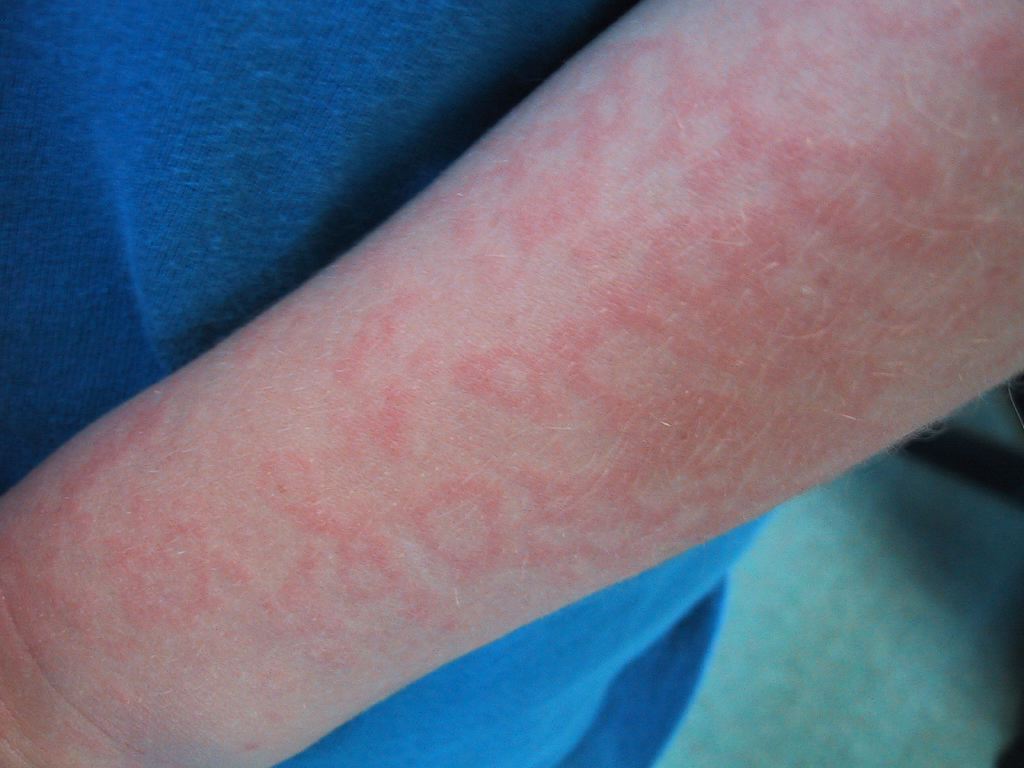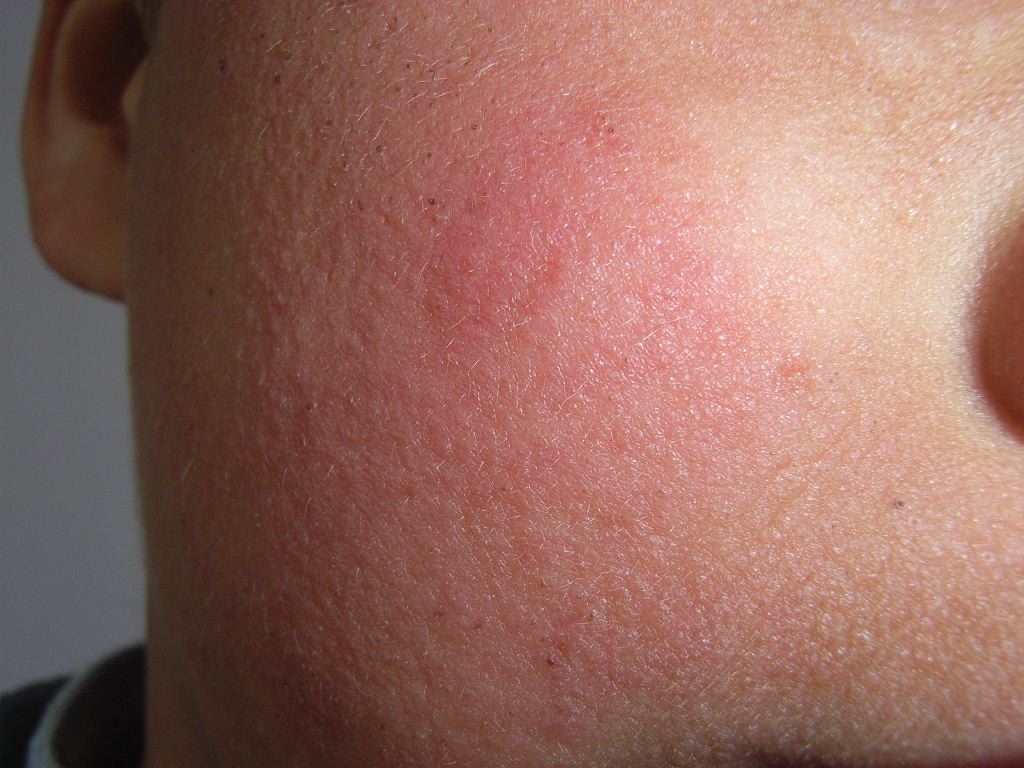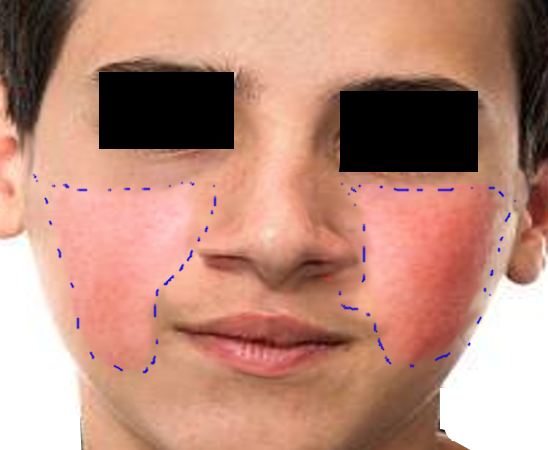Introduction
Erythema infectiosum, also known as 5th disease, is a common viral exanthem primarily affecting children. The disorder is 1 of the 6 classic viral rash illnesses of childhood.[1] This febrile disease typically occurs in children aged 5 to 15 years, though adults may also be affected, albeit less frequently (see Image. Fifth Disease, Arm Rash). The causative agent is human parvovirus B19, which is also implicated in conditions such as aplastic anemia, polyarthropathy, and hydrops fetalis. The infection characteristically progresses through 3 distinct cutaneous phases.[2]
Transmission occurs mainly through respiratory droplets, though hematogenous spread is also possible. Cases are most common in the spring and early summer. Treatment is supportive and focused on symptom management. However, in pregnancy, complications such as transient aplastic crisis or hydrops fetalis warrant special consideration.[3]
Etiology
Register For Free And Read The Full Article
Search engine and full access to all medical articles
10 free questions in your specialty
Free CME/CE Activities
Free daily question in your email
Save favorite articles to your dashboard
Emails offering discounts
Learn more about a Subscription to StatPearls Point-of-Care
Etiology
Parvovirus B19, the causative agent of erythema infectiosum, is a nonenveloped, single-stranded DNA virus belonging to the Parvoviridae family.[4] The virus exhibits a strong tropism for erythroid progenitor cells, leading to its characteristic clinical manifestations. The mechanism of spread most commonly involves inhalation of respiratory droplets. However, vertical transmission from mother to fetus and transfusion-related exposure via infected blood or blood products are also documented routes of infection.
Epidemiology
Erythema infectiosum occurs worldwide and most often affects school-age children aged 5 to 15.[5] Adult cases are less frequent. The infection is most commonly reported during the spring months.[6]
Parvovirus B19 infection during pregnancy may result in severe fetal complications.[7] These conditions include miscarriage, intrauterine fetal demise, and hydrops fetalis.[8] The estimated risk of fetal loss following acute maternal infection is approximately 5%. Pregnant individuals in the 2nd trimester have the highest risk of complications, though adverse outcomes have been documented throughout all stages of pregnancy.[9]
Individuals with sickle cell disease or other chronic hemolytic anemias face increased susceptibility to severe outcomes.[10] Parvovirus B19 infection targets and destroys reticulocytes, leading to reduced or transiently disrupted erythropoiesis. Affected patients may develop transient aplastic crisis, resulting in significant anemia. These individuals often appear acutely ill, with symptoms such as fever, malaise, and lethargy. Clinical findings of aplastic crisis include pallor, tachycardia, and tachypnea, reflecting the severity of the anemia.[11]
Pathophysiology
Parvovirus B19 spreads primarily through respiratory droplets, entering cells within the respiratory tract. Transmission can also occur through exposure to infected blood. Viremia typically develops 5 to 10 days after exposure, and infected individuals remain contagious for approximately 5 days following the onset of viremia. Immunocompetent individuals may remain asymptomatic, experience a nonspecific flu-like illness, or present with the classic facial rash and arthralgias. Patients with aplastic anemia often exhibit markedly elevated viral loads. Once arthralgias and rash appear, patients are no longer contagious and cannot transmit the virus. In fetal infections, hydrops fetalis develops due to impaired red blood cell production, leading to high-output cardiac failure.[12]
History and Physical
The most common and classic presentation of erythema infectiosum is a mild febrile illness with a rash. Initial symptoms of infection can include fever, malaise, myalgias, diarrhea, vomiting, and headache. After initial viremia, the classic erythematous malar rash involving the cheeks with surrounding oral pallor develops. This rash does not appear early in the disease process. The lesion is classically described as a “slapped-cheek rash” and may be the only clinical diagnostic finding (see Image. Fifth Disease, Slapped-Cheek Rash). This facial rash lasts 4 to 5 days. By the time the facial rash develops, the patient usually feels well, and the viremia has resolved. This rash is thought to be immune-mediated (see Image. Fifth Disease, Reticular Facial Rash).
Days after the facial rash develops, a maculopapular rash usually appears on the trunk and limbs. This rash is nonpruritic and typically lasts about 1 week. As it resolves, the rash may take on a lacy or reticular appearance, often more prominent on the extensor surfaces. The palms of the hands and soles of the feet are typically unaffected.[13] Exposure to sunlight or heat may exacerbate the rash.
The infection may also present with arthralgias. Joint symptoms, which are thought to be immune-mediated, occur more commonly in adults than in children, with women being more affected than men. Affected joints are usually symmetric and include the hands, feet, wrists, knees, and elbows. Patients often complain of joint stiffness. No signs of physical joint destruction are observed. Joint involvement typically occurs later in the disease course and resolves after about 3 weeks of symptom onset. When joint symptoms are present, the patient is not considered infectious.
Immunocompromised individuals typically do not exhibit rash or joint symptoms, which are believed to be immune-mediated. Due to an inadequate immune response, these individuals may not develop the typical symptoms of erythema infectiosum. Instead, these patients may experience chronic parvovirus B19 infection, which can lead to neutropenia, thrombocytopenia, or complete bone marrow suppression. Key characteristics of the rash include its potential to cause pruritus in adults, frequent appearance in children (with less than 50% of adults affected), and cessation of infectiousness once it manifests.
Evaluation
Diagnosis of parvovirus B19 infection generally does not require testing due to the self-limiting nature of the disease and its mild symptoms. However, blood tests for specific antibodies may be conducted. Immunoglobulin M antibodies can confirm acute infection, typically appearing 7 to 10 days after virus exposure. These antibodies may remain detectable for 2 to 3 months following infection. Immunoglobulin G antibodies begin to rise about 2 weeks after exposure and provide lifelong immunity once measurable.[14]
Testing is particularly useful in diagnosing aplastic crisis to confirm causality from acute parvovirus B19 infection. Additionally, testing for immunoglobulin G antibodies is common in prenatal care to assess immunity status and evaluate the risk of potential congenital disabilities.
Treatment / Management
The disease process typically resolves without intervention. Symptom control and supportive care form the foundation of treatment for erythema infectiosum. Acetaminophen or nonsteroidal anti-inflammatory drugs may be used to manage fever, arthralgias, and headache when present. Serial hemoglobin and hematocrit monitoring should be conducted if an aplastic crisis is identified on evaluation. Red blood cell transfusions must be administered as needed throughout the course of infection. Close follow-up with an obstetrician is essential when a pregnant patient is diagnosed with acute parvovirus B19 infection early in gestation, including serial ultrasounds to monitor for fetal complications such as hydrops fetalis.
Differential Diagnosis
Several other viral exanthems fall within the differential diagnosis of erythema infectiosum, including measles, rubella, roseola, and scarlet fever. In adults, where arthralgias occur more frequently, the differential may also include influenza and mononucleosis. Noninfectious conditions such as drug hypersensitivity, rheumatoid arthritis, and juvenile idiopathic arthritis should also be considered. Arthritic diagnoses are typically ruled out once joint pain and stiffness resolve, which usually occurs about 3 weeks after symptom onset.[15]
Prognosis
Symptoms of erythema infectiosum are typically mild and self-limited in immunocompetent individuals, with some patients remaining asymptomatic. In contrast, immunocompromised individuals or those with hematologic disorders may experience more severe symptoms. Chronic infection and persistent anemia can develop in immunocompromised patients. Acute infection during pregnancy can lead to fetal complications, including fetal death. The risk of fetal loss is highest when infection occurs before 20 weeks of gestation.[16]
Complications
Complications of erythema infectiosum primarily affect high-risk populations, including immunocompromised individuals, patients with hematologic disorders, and pregnant women. In people with hemolytic anemias such as sickle cell disease or hereditary spherocytosis, parvovirus B19 can trigger transient aplastic crisis, marked by severe anemia and reticulocytopenia that often necessitate transfusion. Immunocompromised individuals, including those with human immunodeficiency virus or undergoing chemotherapy, may develop chronic infection, resulting in persistent anemia or pure red cell aplasia.
In pregnancy, vertical transmission can lead to hydrops fetalis, severe fetal anemia, or intrauterine fetal demise, especially when infection occurs during the 1st or 2nd trimester.[17] A postviral arthropathy resembling rheumatoid arthritis may develop in adults, presenting as symmetric polyarthritis of the hands, wrists, and knees. Rare neurologic complications, such as encephalitis, myocarditis, and vasculitis, have also been reported.
Deterrence and Patient Education
Deterrence and patient education for erythema infectiosum emphasize limiting transmission, recognizing complications in high-risk groups, and managing symptoms. Parvovirus B19 spreads through respiratory droplets, so proper hand hygiene, respiratory etiquette, and avoiding close contact with symptomatic individuals are essential preventive strategies. However, subclinical infections can make prevention difficult.
Most patients may be reassured that the illness is self-limiting. Supportive care with antipyretics and analgesics addresses fever and joint discomfort.
High-risk individuals, including pregnant women, those with hemolytic disorders, and immunocompromised patients, should be counseled to seek medical attention after known exposure. Early evaluation may help prevent complications such as hydrops fetalis or aplastic crisis.
Healthcare providers and caregivers should recognize that the period of highest infectivity occurs before the appearance of the facial rash. No vaccine is currently available, highlighting the importance of education and timely risk assessment.
Pearls and Other Issues
Important pointers about erythema infectiosum to communicate to patients and caregivers include the following:
- This common viral exanthem typically affects children, especially during the spring months.
- The classic diagnostic feature is a bright red rash on the cheeks with perioral pallor, often described as a "slapped cheek" appearance.
- Extra precautions are necessary for individuals who are pregnant due to the risk of fetal complications, such as hydrops fetalis.
- Patients with sickle cell disease or other hemolytic conditions are at risk for aplastic crisis and require closer monitoring.
Although the illness is generally mild, certain populations face serious risks. Empowering families with this knowledge is essential for prevention.
Enhancing Healthcare Team Outcomes
Erythema infectiosum is a generally benign viral illness in children and is often managed by pediatricians, emergency medicine physicians, internists, and nurse practitioners. When the infection is diagnosed in a pregnant patient, an obstetrics consultation should be obtained due to the risk of complications such as aplastic crisis and hydrops fetalis. These patients require close monitoring throughout the remainder of the pregnancy.
Nursing staff should ensure that immunocompromised individuals are appropriately isolated and monitored. Patient education should emphasize the importance of proper hand hygiene and standard infection control practices. Parents should be reassured that the rash is not contagious, and children do not need to be excluded from school once the rash has appeared.
Pharmacists play a role in counseling families that no specific antiviral treatment is available and that the rash typically resolves without intervention. In cases involving immunocompromised individuals or pregnant patients, timely referral to the appropriate specialists is strongly recommended to optimize outcomes.
Media
(Click Image to Enlarge)
(Click Image to Enlarge)
(Click Image to Enlarge)
References
Mende M, Sockel K. Parvovirus B19 Infection. The New England journal of medicine. 2018 Dec 13:379(24):2361. doi: 10.1056/NEJMicm1807156. Epub [PubMed PMID: 30575471]
. Fifth disease (erythema infectiosum). Mother To Baby | Fact Sheets. 1994:(): [PubMed PMID: 35951969]
Gigi CE, Anumba DOC. Parvovirus b19 infection in pregnancy - A review. European journal of obstetrics, gynecology, and reproductive biology. 2021 Sep:264():358-362. doi: 10.1016/j.ejogrb.2021.07.046. Epub 2021 Jul 28 [PubMed PMID: 34391051]
Rogo LD, Mokhtari-Azad T, Kabir MH, Rezaei F. Human parvovirus B19: a review. Acta virologica. 2014:58(3):199-213 [PubMed PMID: 25283854]
Level 3 (low-level) evidenceJacquot R, Gerfaud-Valentin M, Mekki Y, Billaud G, Jamilloux Y, Sève P. [Parvovirus B19 infections in adults]. La Revue de medecine interne. 2022 Dec:43(12):713-726. doi: 10.1016/j.revmed.2022.08.005. Epub 2022 Sep 8 [PubMed PMID: 36088203]
Vafaie J, Schwartz RA. Erythema infectiosum. Journal of cutaneous medicine and surgery. 2005 Aug:9(4):159-61 [PubMed PMID: 16502203]
Kagan KO, Hoopmann M, Geipel A, Sonek J, Enders M. Prenatal parvovirus B19 infection. Archives of gynecology and obstetrics. 2024 Nov:310(5):2363-2371. doi: 10.1007/s00404-024-07644-6. Epub 2024 Jul 29 [PubMed PMID: 39073431]
Kontomanolis EN, Fasoulakis Z. Hydrops Fetalis and THE Parvovirus B-19. Current pediatric reviews. 2018:14(4):239-252. doi: 10.2174/1573396314666180820154340. Epub [PubMed PMID: 30124157]
Dittmer FP, Guimarães CM, Peixoto AB, Pontes KFM, Bonasoni MP, Tonni G, Araujo Júnior E. Parvovirus B19 Infection and Pregnancy: Review of the Current Knowledge. Journal of personalized medicine. 2024 Jan 26:14(2):. doi: 10.3390/jpm14020139. Epub 2024 Jan 26 [PubMed PMID: 38392573]
Borsato ML, Bruniera P, Cusato MP, Spewien KE, Durigon EL, Toporovski J. [Aplastic crisis in sickle cell anemia induced by parvovírus B19]. Jornal de pediatria. 2000 Nov-Dec:76(6):458-60 [PubMed PMID: 14647635]
Leung AKC, Lam JM, Barankin B, Leong KF, Hon KL. Erythema Infectiosum: A Narrative Review. Current pediatric reviews. 2024:20(4):462-471. doi: 10.2174/1573396320666230428104619. Epub [PubMed PMID: 37132144]
Level 3 (low-level) evidenceTschöpe C, Ammirati E, Bozkurt B, Caforio ALP, Cooper LT, Felix SB, Hare JM, Heidecker B, Heymans S, Hübner N, Kelle S, Klingel K, Maatz H, Parwani AS, Spillmann F, Starling RC, Tsutsui H, Seferovic P, Van Linthout S. Myocarditis and inflammatory cardiomyopathy: current evidence and future directions. Nature reviews. Cardiology. 2021 Mar:18(3):169-193. doi: 10.1038/s41569-020-00435-x. Epub 2020 Oct 12 [PubMed PMID: 33046850]
Level 3 (low-level) evidenceAllmon A, Deane K, Martin KL. Common Skin Rashes in Children. American family physician. 2015 Aug 1:92(3):211-6 [PubMed PMID: 26280141]
Molenaar-de Backer MW, Russcher A, Kroes AC, Koppelman MH, Lanfermeijer M, Zaaijer HL. Detection of parvovirus B19 DNA in blood: Viruses or DNA remnants? Journal of clinical virology : the official publication of the Pan American Society for Clinical Virology. 2016 Nov:84():19-23. doi: 10.1016/j.jcv.2016.09.004. Epub 2016 Sep 13 [PubMed PMID: 27664778]
Gable EK, Liu G, Morrell DS. Pediatric exanthems. Primary care. 2000 Jun:27(2):353-69 [PubMed PMID: 10815048]
Valentin MN, Cohen PJ. Pediatric parvovirus B19: spectrum of clinical manifestations. Cutis. 2013 Oct:92(4):179-84 [PubMed PMID: 24195090]
Boissiere J, Watkins V, Kuller JA, Dotters-Katz SK. Parvovirus B19 in Pregnancy. Obstetrical & gynecological survey. 2024 May:79(5):281-289. doi: 10.1097/OGX.0000000000001263. Epub [PubMed PMID: 38764205]
Level 2 (mid-level) evidence

